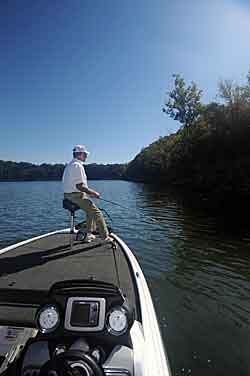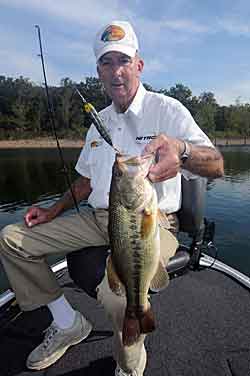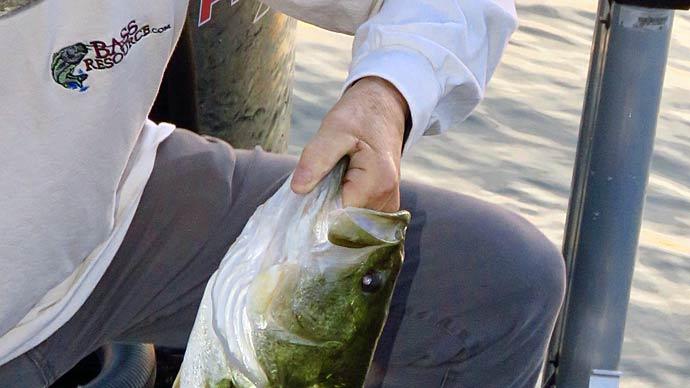
A few years ago, I witnessed a crowd of Bassmaster Elite Series pros, including Kevin VanDam and Edwin Evers, that had gathered at Big Cedar Lodge Marina to watch a Zara Spook sashay back and forth across the surface.
It was break time during the Nitro Media Days at Table Rock Lake, and the pros were watching topwater maestro Charlie Campbell give a clinic on how he “walks the dog” with a Heddon Zara Spook. Campbell no longer competes in national tournaments, but the Bass Fishing Hall of Fame member is still respected by today’s pros as a master of the walking the dog technique.
Later that day on Table Rock Lake, I watched Campbell walk a Spook around and through the limbs of a cedar tree, and when he stopped the cigar-shaped plug next to the base of the tree, a hefty largemouth bass engulfed the lure. Cedar trees with limbs sticking 1 to 2 feet out of the water are Campbell’s favorite targets for walking a Spook.
“Walking the dog” is the zigzagging retrieve used for various cigar-shaped topwater lures that walk across the water while twitching your rod. “You must have the right rod and reel and the right line to have your Spooks walk right,” Campbell says. The Missouri angler favors a 5 1/2-foot pistol grip casting rod in a medium-light action. The rod has a limber tip which softens the pull as Campbell jerks the rod and helps impart better side-to-side action from the lure. A high-speed reel is also standard equipment for Campbell when “walking the dog” because he wants to reel in line quickly after a strike rather than jerking the rod and pulling the lure away too fast from a fish.
The topwater specialist opts for monofilament line for walking the dog. He believes fluorocarbon is too stiff and tends to sink, preventing him from working the Spook correctly. For the original size Spook and a Super Spook, Campbell selects 14-pound test line and scales down to 10-pound test for the smallest Spooks.

Campbell notes not all walking baits are made the same, so you might have to do some tweaking to get the lures to walk right. He prefers his walking bait to sit with the back half of the plug under the water. If the plug sits flat on the surface, he changes the hooks or adds some weight to the rear of the lure to make it stand up more. Campbell also recommends adding a split ring or snap swivel to the lure’s line tie, which helps the Spook swing more freely and walk better. The topwater expert has experimented with feathered tail hooks on his Spooks to enhance the lure, but he noticed the feathers put too much drag on the lure and inhibited the walking action of his Spooks.
According to Campbell, getting a rhythm going is the best way to walk the dog. He recalls when he used a radio in his boat and fished with a friend who could never work a Spook correctly. “One day, I had this old honky-tonk music on, and I had that Spook just working to the tune of the music, and he asked me if that is how I practiced (walking the dog),” Campbell recalls. “I said yeah, just listen to the beat of the music.”
Campbell gets the beat going with a cadence of short jerks of his rod with his wrists while reeling in line simultaneously. Working the wrists is the key to the retrieve because jerking with the forearms causes the plug to move across the surface too fast and prevents it from walking. Another key to the retrieve is keeping some slack in your line as you twitch and reel so the plug will zigzag easier. Keeping too tight of a line during the process causes the plug to come back straight.
The former Bassmaster competitor can also walk the surface plug around a piece of cover by twitching his wrists, but he only takes about one-eighth of a turn of the reel. This process keeps the lure close to the target yet allows the lure to swing free of the snags. The Spook will glide away from the strike zone if he jerks or reels too much during this time.
The speed at which Campbell walks his Spook depends on the fish's mood. “I will work it fast or slow,” he says. “I always try to put myself in the fish’s position. If I am a fish under a cedar tree and that bait comes across there, I wonder how I will get it.”
Campbell knows fall is a good time for bass to get a Zara Spook because the fish suspend in trees or around other cover during this season. So now is an excellent time to start walking the dog.




